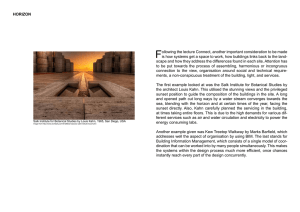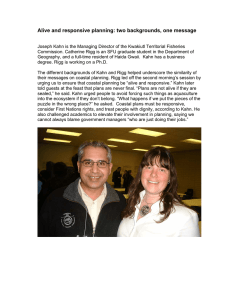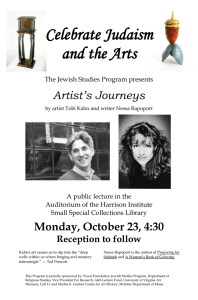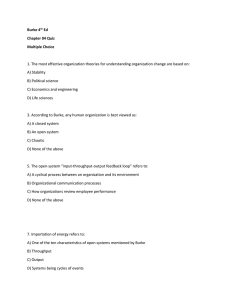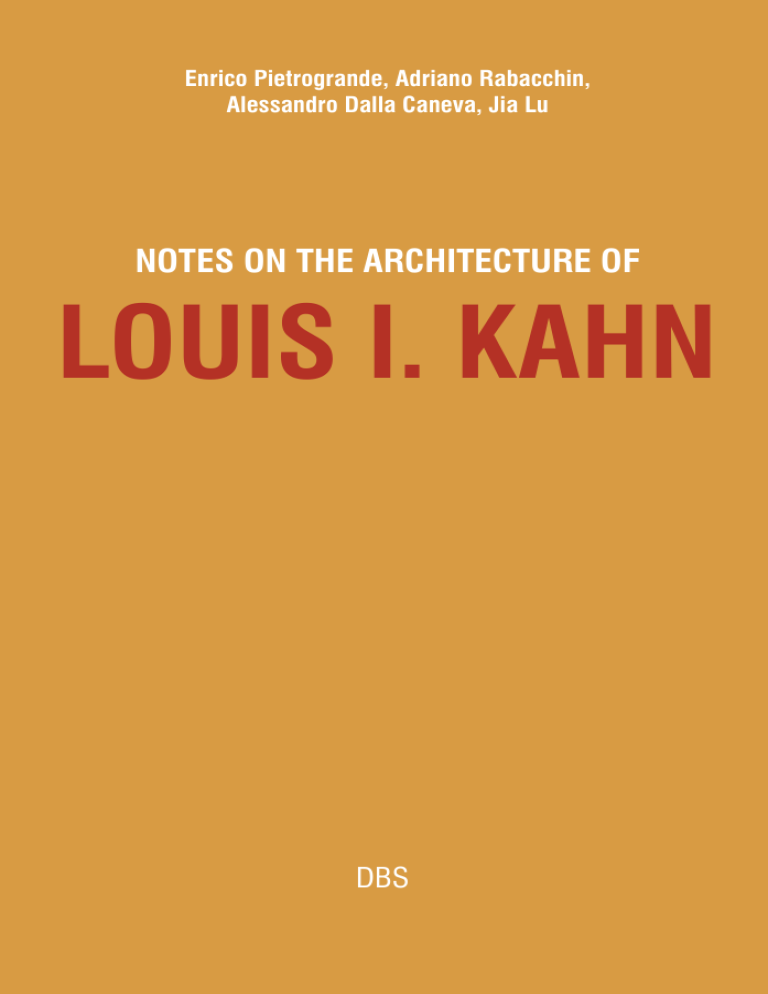
Enrico Pietrogrande, Adriano Rabacchin, Alessandro Dalla Caneva, Jia Lu NOTES ON THE ARCHITECTURE OF LOUIS I. KAHN DBS 1 This book was translated from the original Italian by the Oxford University graduate Clive Prestt. 2 Contents 7 Introduction 9 The ‘inbetween’. Observations on materials and technologies used by the architect Louis Kahn Enrico Pietrogrande 37 Louis Kahn. The architecture of the house Adriano Rabacchin 47 Louis Kahn and the Mediterranean. The spirit of classical antiquity as a compositional method Alessandro Dalla Caneva 61 Louis Kahn’s Dramatic Light Jia Lu 71 Ehle House, Haverford, 1947-1948 Adriano Rabacchin 77 Casa Morris, Mount Kisco, New York, 1955-1958. Representation of the house using ancient styles Alessandro Dalla Caneva 87 The Fleisher House, Elkins Park, Pennsylvania, 1959. The evocative nature of shape Alessandro Dalla Caneva 97 Fisher House, Hatboro, Pennsylvania, 1960-1967 Jia Lu 107 Korman House, Philadelphia, 1971-1973 Jia Lu 117 Bibliography 123 Sources of illustrations 3 4 Introduction The idea of collecting several papers dedicated to specific aspects of the architecture of Louis Kahn occurred to me some years ago during the academic year 2011-12 in connection with the exercises on my Urban and Architectural Composition course dedicated to the Twentieth century master*. At that time I and other members of the teaching group had a few doubts about the subject. Limiting ourselves only to the one-family dwellings Kahn actually built, we asked the students to develop a small independent supporting building located nearby. However, the exercises convinced us to deepen the projects on the master together with the pupils since some of our reflections would be useful to future students. As mentioned above, the papers deal with specific aspects of Kahn’s architecture. Firstly, I looked at the materials and construction elements that both Kahn and the neo-brutalist movement used in the 1950s and that superseded the theoretical positions of the Modern Movement. Together with the Smithsons’ projects, the frank exposure of the material and the undiluted exhibition of the construction process in Kahn’s architecture still influence a lot of creations in architecture today, above all in Switzerland and England. The papers contributed by Adriano Rabacchin are dedicated to the one-family dwelling, a project theme that Kahn practiced continuously but about which relatively 5 little is known in both the master’s introductory studies and examples he developed. So Rabacchin analyses the Ehle house. Alessandro Dalla Caneva’s contribution is a theoretical consideration of the subject of building composition in the Latvian master’s projects. On the one hand, the project experience concerns understanding the importance of representation in the form and on the other hand understanding the methods through which the idea can be recognised in the form of the construction. Jia Lu is a Chinese architect who trained at the University of Harbin. In his chapters in this book he looks at the way Kahn used light by examining extraordinary examples in the Fisher house and the Korman house. Lastly, given the complexity of thought and complexity of the projects by the man who for many is the most important architect of the last century, and while this book is a fragmented study, the report it presents concludes that he was the most appropriate architect for fulfilling projects with a multiplicity of characteristic features that cannot be reduced to a single unit. Enrico Pietrogrande * This is the teaching of the Architecture and Urban Composition 2 (co-teachers Adriano Rabacchin, Alessandro Dalla Caneva) on the degree course in Building Engineering - Architecture at the University of Padua (Department of Civil, Environmental and Architectural Engineering). 6 Louis Kahn and the Mediterranean. The spirit of classical antiquity as a compositional method Alessandro Dalla Caneva Examining the work of Louis Kahn today is still a good idea since original thinking having its origins in mankind’s existence and aspirations is always valid, at least in this writer’s opinion1. The feeling of fleeting impermanence that distinguishes schemes in our times makes it very interesting for us to look at Kahn’s work and find the idea of a civil architecture whose reasoning evokes the feeling of the individual belonging to shared values2 which is deeply deposited in its form. Kahn mainly considered himself to be an artist and that architecture is a medium for art3 and Kahn’s personal experience represents an invitation to examine reality with wonder and amazement as if it were the first time4 everything that is above, beyond, and deeper than the actual appearance of things has been imbibed and distinguished by separating what is there permanently from what is 45 1. Batptistery of Saint John, Siena (1951). fleeting and ephemeral. The real and authentic feeling of knowledge is essentially produced by an ecstatic passage5 from the reality to an elusive, immobile, and longedfor place of origin6. Every ideation is triggered by this spark of imagination7. A start full of faith, wonder, and silence8. The job of art itself is to reveal this universal and ideal content in the external form of the appreciable, conferring beauty on what obeys an aim, a purpose, an end. The aim is to represents the deeper reasoning for gathering the nature of what a building needs and must be. The idea that powerfully contains the building’s identity comes from the exhibition of this will to live9. The form and its functional reasons are expressed in it, as well as the essence around which the compositional 46 2. Piazza del Campo, Siena (1951). plan being defined by it too. Its achievement is brought about by using the principle of decorum that confers appropriate form on the construction so that it achieves its function. The items composing the construction are subordinate to the main idea of the general aim being revealed appropriately. The understanding of what then became a method in composition came to Kahn clearly during travels in the Mediterranean world of Italy, Greece, and Egypt in the Spring of 1951 in which Kahn experienced a moment of revelation and confirmation of how the ancient world knew how to represent durable values of civil life in architecture. The spirit of classical antiquity in Roman buildings reveals the need to refind that monumental 47 3. Rome (1951). character in the fullness of the forms handed down to our times but which seem to be lacking in contemporary buildings. The ancient buildings take care of the feeling of monumentality in the cracks in the construction and these have become examples to modern society for the new institutions it needs to construct10. It clearly defines the idea of how the nature of a project transcends the architectural plan to achieve the essence of the human activity with which it is bound. The Pantheon is exemplary in exalting the urgent need to transcend the particular rite in order to express a higher purpose than the lay or religious components11 which form a specific aspect 48 4. Roman ruins (1951). contained within the general idea. While this purpose in the Pantheon finds expression by being measured using an instrumental space sublimated in the Egyptian ideal that was maximally expressed in the pyramids, the ideal is expressed without any mediation by the predetermined space that demonstrates the pure expression of “higher thought” very strongly (Hegel)12. Furthermore, it is the feeling of starts that Kahn felt was questioning him when he contemplated ruined buildings such as the thermal baths of Caracalla. In this case he contemplated the sense of ideation since what remains after the loss of function is the condition that 49 5. Acropolis, Athens (1951). exalts the ultimate meaning of the building13. According to Kahn, if there is a romantic aspect, this becomes clear when the ancient monument recovers the irrational component. A good architectural project stirs emotion in us. Above all, it is in the monument that the collective feeling assumes its highest expression. It is the emotional rush as an emotional given that needs to be incorporated in the project. Not only the forms but also ideas and emotions are gathered from history to represent the values of our times. Consequently, the tradition is not so much the recovery of a formal experience as the assimilation of the essence contained in the reality14. Whether traceable to the classical world or the Roman world, ancient buildings have above all handed down all of these purposes in that it 50 6. Parthenon, interior, Athens (1951). considers and identifies the general value that represents an invariable including when the building changes or loses its original function. It is the feeling of monumentality, the interpretation of a symbolic code revealed in the ancient form to be recomposed over and above the building reasons, the typological interpretation, and an evolutionary conception of architecture that Kahn did not appear to be interested in since he was driven by research into the metahistorical archetype15: “Once again the dilemma between the past and present arises: perhaps form (content), inspired by dreams, is only really nothing other than the memory. It is perhaps in some way a model, something that has always existed in the past (…)?” (V. Scully). Once this leap has been made without any temporal51 7. Temple of Apollo, Corinth (1951). spacial constrictions in the inaccessible place of the origins, freedom is justified due to typological inventions whose reason for being is the sense of order that establishes geometric relationships full of meaning. The meaning from which everything is created having been clarified, and the true place of architecture in a region where appearance is more important than reality having been identified, understanding how the gold dust of the essential constructs a body appropriate to expressing that entirely inner meaning becomes necessary. Furthermore, the monuments and stones of Ancient Rome immediately offer themselves as a means through which to understand the methods by which the monumental assumes a material substance that corresponds consistently. It is not only the 52 8. Temple of Amon, Karnak (1951). discovery of what but also of how the incommensurable can take shape in spaces and time by adapting to the circumstances. Architecture in Roman times was researched for its material structure and the construction components used to create the form (content) of the building. Even more than Greece or Egypt or the rest of the ancient Mediterranean world, what Rome was able to restore was the wonderful sense of the conforming space that the building forms create. The imposing powerful brick and stone walled constructions are expressed as if their aim is to make their form appropriate to the space that in culturally exalting the function, expresses the general aesthetic idea16. One comes to understand how those important spaces demonstrate their nature in clear 53 9. Pyramids, Giza (1951). correspondence to the logic of the construction17 so that the space is not obscured but rather revealed by the light18 that picks out the profile and surfaces in the building’s parts. Being luminous and crystalline in its physical presence, the space cannot but be organised to modulate the parataxical composition of the box type volumes that are rigorously positioned to make the general aim recognisable, an aim that does not lie in the circumstances but in the expression of the institution. The Roman lesson has the feeling of déjà vu when Kahn’s experiences as a young man at the Academy of Beaux Arts in Philadelphia and the hours spent mastering a method that found its reason to exist in putting the rational principles of French 54 10. Ptolemaic Temple, Edfu (1951). Illuminism into operation are taken into acount19. The nature of the classic landscape that emerges “from the intelligent composition of the distinct elements”20 could not produce forms coherent with the genius loci in which the fullness of the light in the sunny Mediterranean climate cuts the volumes in the blue sky, revealing the plastic incorruptibility and chiaroscuro light and shade rhythm of the pure and absolute forms. It is precisely the latter that reveal the immeasurable tension with disarming amazement, brought into play by combining simple forms21 as if the simplicity were functional in the recognition of the building’s nature. It is confirmation of the formal choice that characterised the best of Kahn’s 55 production that opposed the International Style dogmas of his time. After the stay in the Mediterranean world, this compositional method was developed coherently in the schemes that make Kahn the continuer of a monumental tradition in architecture. Construction that nostalgically re-proposes the durable symbols of civil life. Consequently, Kahn’s real aim seems to be to recreate a world rising out of the ruins of the long-departed reality drawn in by a fiction that is configured as if it were the real and true indisputable reality. So the composition is functionally snatched out of the human world’s transience, oblivion, and death forever conferring on it a sense of a wider, richer, and deeper dimension of life, less reality and more idealism. Notes 1 “I believe also that a building must be answerable to an institution of man. What is instituted by men is that which has the approval of man, or rather this sense of institutionalizing or making of the institution of man, comes from our inner inspirations”. Kahn 1964, pp.170-171. 2 “He is the architect for the great occasion, for institutions, churches, synagogues, museums, universities, and capitals. His architecture gives form to what is tending to disappear or has no form in the contemporary world: cult locations – of religious cults, taste, culture – but also faceless institutions that the world submerges and destroys. His architecture aims to put a collective value back into operation". Tafuri and Dal Co 1976, p. 408. 3 “My father has always been considered to be an artist, in fact, he would have liked to have been a painter and exhibit his paintings but when he discovered architecture, constructing buildings became his artistic medium”. Sue Ann Kahn, My father and a day in Rome, in: Barizza and Falsetti 2014, p. 54. 4 “I believe wonder is the motivator of knowledge”. Kahn 1961, p.124. 5 “Within us is the complete story of how we were made, and from this sense, which is the sense of wonder, comes a quest to know, to learn, and the entire quest, I think, will add up to only one thing: how we are made. I think our entire quest for knoweledge is only that: how we are made”. Kahn 1964, p.171. 6 “What seems to interest the Lithuanian American teacher is the interception of one secret layer of architecture, an implicit level in which time and with it 56 history do not pass, being configured as something that has absolutely stopped, that finds a reason for its own existence in its stability”. Franco Purini, Il luogo dell’origine, in Di Petta 2010, p. 9. 7 “I love beginnings. I marvel at beginnings. Beginnings are that which confi rm its continuation. (...) It’s in my character to want to discover beginnings”. Kahn 1972, p. 150. 8 “Today, building needs an atmosphere of belief for the architect to work in. Belief can come from recognizing that new institutions want to emerge and be given expression in space”. Kahn 1973, p. 257. 9 As Kahn said in a letter to Balkrishna V. Doshi at the origin of every work is an idea. 10 “The images we have before us of monumental structures of the past cannot live again with the same intensity and meaning. Their faithful duplication is unreconcilable. But we dare not discard the lessons these building teach for they have the common characteristics of greatness upon which the buildings of our future must, in one sense or another, rely”. Kahn 1944, pp. 22-23. 11 “This building (Pantheon) had no precedents: its motivation was clear and full of belief. The force of its wanting to be inspired a design equal to its desires in form.” Kahn 1973, p. 257. 12 “When you see the pyramids now, what you feel is silence. As though the original inspiration of it may have been whatever it is, but the motivation that started that which made the piramids, is nothing but simple remarkable”. Kahn 1968, p. 240. 13 “I note when a building is being made, free of servitude, that the spirit to be is high allowing not a blade of grass in its wake. When it stands complete and in use its seems like it wants to tell you about the adventure of its making. But all parts locked to serve makes this story of little interest. When its use spent and it becames a ruin, the wonder of its beginning appears again. It feels well to have itself entwined in foliage, once more high in spirit and free of servitude”. Kahn 1968, p. 229. 14 “This led me to realize what may be Tradition. Whatever happens in the circumstantial course of man’s life, he leaves as the most valuable, a golden dust which is the essence of his nature. This dust, if you know this dust, and trust in it, and not in circumstances, then you are really in touch with the spirit of teradition. Maybe then one can say that tradition is what gives you the power of anticipation from which you know what will last when you create”. Kahn 1967, p.227. 15 “There is something that pulls on you as though you were reaching out something primordial, something that existed much before yourself. You realize when you are in the realm of architecture that you are touching the basic feelings of man and that architecture would never have been part of humanity if it weren’t the truth to begin with”. Kahn 1968, p. 27. 16 “Reflect on the Pantheon which is recognize as one of the greatest of buildings. Its greatness has many facets. It is the realization of a conviction that a building could be dedicated to all religions and that this ritual free space can be given expression. It presents a belief of a great man which led to its design as a non directional domed space. If architecture may be expressed as 57 a world, then this building expresses it well, even refi ning it, by placing the oculus, the only window, in the center of the dome”. Kahn 1973, p. 257. 17 “The architectural space is one where the structure is apparent in the space itself. A long span is a great effort that should not dissipated by division within it. The art of architecture has wonderful examples of spaces within spaces, but without deception. A wall dividing a domed space would negate the entire spirit of the dome”. Kahn 1973, p. 257. 18 “A voult, a dome, is also a choise of a character of light”. Kahn 1967, p.224. 19 “We need Boullée, we need Ledoux, Boullée is, Ledoux is, Thus Architecture is”. Kahn 1967, p.223. 20 Norberg-Schulz 2003, p. 45. 21 Kahn said that in Italian architecture all of the possible combinations of pure form have been experimented. See Louis Kahn in Di Petta 2010, p. 24. 58 Casa Morris, Mount Kisco, New York, 1955-1958. Representation of the house using ancient styles Alessandro Dalla Caneva The Trenton Bathhouse of 1955 forms a reference point for studying Kahn’s use of differentiated space1. There are several preparatory drawings of the house, which was not built, at Mount Kisco in New York State that were sketched at the time for Lawrence Morris. There are two distinct versions that refer to a process of definition of the dwelling’s form in which the study of the individual structural units represents the leitmotiv unifying both versions according to a procedure progressively aggregating the individual cells in meaningful unity. It should also be noted how the first version is strongly analogous with the project for another public building, the Richards Medical Research Building of 1957 that brought Kahn’s ideas for differentiated spaces into being, conforming to its own rational and visible building structure. This attitude can be interpreted in the light of Kahn’s Beaux Art training 75 1, 2. Plan sketch, first version (left), definitive plan (right) of the Morris House (1955-1958). and his Roman experience. In particular, the latter led to reflective meditation on the idea of differentiated space where each individual entity is clearly recognisable inside the entire ensemble. In exploding the international myth of continuous undifferentiated space, Kahn revised the way contemporary architecture is understood by forcefully proposing the idea of recognisable space unspoilt by interruptions that infringe nature: “Architecture deals with spaces, the thoughtful and meaningful making of spaces. The architectural space is one where the structure is apparent in the space itself. A long span is a great effort that should not dissipated by division within it. The art of architecture has wonderful examples of spaces within spaces, but without deception. A wall dividing a domed space would negate the entire spirit of the dome”2. The idea of the autonomous spatial unit forcefully persists even when the second version of the project tends to incorporate the individual units inside the same perimeter 76 3. Elevation sketch of the Morris House (1955-1958). in a more stringent relationship between the ground floor and raised parts according the principles of the picturesque that in the asymmetry and misalignments are reminders of the typical methods of medieval architecture that Kahn pondered with interest. This does not mean that the house grows arbitrarily but is always subject to a principle of order that confers a solemn character typical of ancient architecture. However, what amazes in the Morris house is the image of an ancient ruin with the three-dimensional version perhaps offering memories of ancient castles or medieval ruins that make us forget the passing size of the dwelling for a moment and lead us inside a symbolic vision of architecture as a place representing the ideal with specific values. We know that the theme of ruins was dear to Kahn’s heart precisely because the sense of its design strongly emerges in the form of a ruin, that is, the main reason underlying the creation of the building: “But when 77 4. Sketch of the Pennsylvania Medical Research Towers (1956). the building is a ruin and free of servitude, the spirit emerges telling of the marvel that a building was made”3. In the lack of life that characterises a ruin, it is precisely in the ruin losing its function that it manifests the true sense of knowledge, the true aesthetic intention that motivates the design and represents all that is most authentic in tradition: “Whatever happens in the circumstantial course of man’s life, he leaves as the most valuable, a golden dust which is the essence of his nature. This dust, if you know this dust, and trust in it, and not in circumstances, then you are really in touch with the spirit of tradition. Maybe then one can say that tradition is what gives you the power of anticipation from which you know what will last when you create”4. The design re-proposing the ancient idea of monumental character with the meaning concealed in the form certainly leads to the extreme consequen78 5. Sketch of walls of Carcassonne (1959). ces of recovering forms or citations of the ancient world such as castles or medieval manor houses. The modern historiography has underlined how the Morris house has close links with the Richard Lloyd Jones house by Frank Lloyd Wright in terms of the alternating verticalism of glass and masonry reconfiguring the external form in fascias. Nevertheless, it is undeniable that the strength of the images arising out of the volumetric designs and signifying a monumental dimension that remind us of the silhouettes of medieval castles or their vertical parts signifying the evocative towers that Kahn would later use in the Richards Medical Research Building, excellent examples referring to the slender towers of San Gimignano that Kahn saw during his first journey through Italy in 79 1929. Here too the form of the Morris house is enriched by allusions and has meaning transcending the temporary appearance. On the other hand, the raison d’être of the vertical parts has no functional counterpart and can only be interpreted as a mask interposed on the façade. The search for the symbolic dimension of the Morris house is made less banal in the contemporary Richards Medical Research Building project in which the evocative language of the towers is united with the practical needs of the functional plan of empty spaces with columns or stairs inserted to distribute the air. Even the technical and minor spaces, always considered secondary, assume their role within the project and make a contribution to the meaning of the form. Infact as Kahn said the nature of the space is further characterised by the minor service spaces. Storerooms and cubiculums must not be areas divided by partitions with the same spatial structure but must be given their own structure. The dyssimmetrical arrangement of the spaces on the plan had immediate implications for the interpretation of the picturesque perception of the volumes in the space, not only alluding to the typical reasons for composing the form according to the Nordic European world but also to the Mediterranean world (Villa Adriana). Form, size, dimensions, hierarchies, and orientation of the spaces are the result of composition valuing the principle of “architecture is the thoughtful making of spaces. It is, note, the filling of areas prescribed by the client. It is the creating of spaces that evoke a feeling of appropriate use”5. The suggestion of Villa Adriana reveals this intention in that it is “a kingdom of spaces made to evoke their use”6. The 80 6. San Gimignano’s towers (1929). monumental nature of the Morris house is no different to what was pursued in projects contemporary with it in that it demonstrates the method of moulding the meaningful form of the Roman lesson from which Kahn learnt the 81 7. Frank L. Wright, Richard Lloyd Jones House, Tulsa, Oklahoma (1928-1931). strength of the wall and the power of light and shade, that is, chiaroscuro. Once again the profound septums articulate the main prospect of the house and measure the rhythm of a succession of full and empty alternations of light and darkness that evokes characteristics recurring in Roman or Greek architecture: “A plan of a building should read like a harmony of spaces in light. Even a space intended to be dark should have just enough light from some mysterious opening to tell us how dark it really is. Each space must be defined by its structure and the character of its natural light”7. Consequently, the rhythmic arrangement of the septums is a studied device to obtain a light effect. Paradoxically, from the moment that complex inventions are used to transform the medieval walls of a domestic house into meaningful and evocative forms, the search for monumentality still seems to be more evident when referring to domestic architecture. Perhaps the Morris House latently possesses the search found in the Unitarian church in Rochester or in that most successful of projects, the Esherick house in which the prospect is 82 presented “with a strong predominance of the full on the empty spaces alternating in a compact tight sequence of septum walls like blinds on the sides windows that subdivide and so break up the external surfaces (...)” and “the increase in the walls’ depths provides the pretext to insert fixtures and fittings on the inside”8 marrying a functional solution with the most truly evocative reason in a new way. How the theme of Kahn’s domestic dwelling persistently transforms an exclusively real but temporary fact is also striking, elevating it to the monumental by going beyond details to a more general dimension: “I now read Goethe, and I find there is wonder in it. He calls his autobiography truth and poetry. This is a wonderful realization of life and the course of living. Though he reported what happened to him, he always avoided confining it to the circumstantial, or what happened, but reflected on its meaning, which trascended his own life. And this I think was marvelous (...). That was wonderful, I thought, and that is really art”9. Kahn’s aim seems to have been arranged so that it sublimates the real into a deeper and more real dimension of life in which the design transforms empiri- 8. Model of the Morris House (1955-1958). 83 cal facts into meaningful occurrences and allows access to a higher level of existence: “Architecture has little to do with solving problem. Problems are run of the mill. To be able to solve a problem is almost a drudgery of architecture. Though it is tremendously delightful, there is nothinh equal to the delight of coming to realizations about architecture itself. Man will reject that which is not the truth. Many attempts that have been made in earlier times to make things exist and perpetuate themselves have failed because they weren’t the truth”10. Through composition Kahn could understand the transience, oblivion, and death of the human world while always conferring a meaning on it. Through connections full of meaning, the building constructed brings into life the ultimate feeling of life against the transience of natural existence. In addition, we cannot but believe that this is Kahn’s real aim as he has always considered architecture to be a medium through which art is expressed. Notes 1 “The idea he used in his work was a building without any predefi ned function to make it totally flexible for every possible use (...) It is clear that Kahn was persistently extending his principle of self-sufficient spatial unity by now (...)”. Braghieri 2005, p. 38. 2 Kahn 1973, p. 257. 3 Kahn 1971, p. 484. 4 Kahn 1967, p.227. 5 Kahn 1960, p. 68. 6 Bonaiti 2002, p. 40. 7 Kahn 1960, p. 68. 8 Fumo and Ausiello 1996, pp. 112-113. 9 Kahn 1963, p. 165. 10 Kahn 1968, p. 27. 84
